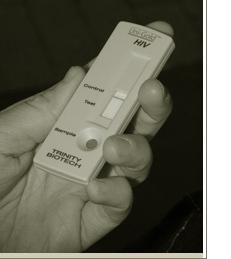A few weeks ago when I wrote my second blog entry, I proposed questions asking how personal treatment changes if a person contracts HIV. I was curious about how relationships work in such circumstances, and if interpersonal distancing is an inevitable consequence. According to a recent article in the New York Times, As HIV Babies, Come of Age, Problems Linger, it seems that many of my suspicions are sadly true.
This article was particularly evocative because the subjects who were interviewed did not contract the virus personally, but rather were born infected. As drugs have been developed to fight HIV and extend livelihood for those infected, around 10,000 babies born with the virus in the early 1990’s have been able to live through their adolescences. In order to stay alive, theses children have had to take medication since birth, often multiple pills daily to survive. Some children’s bodies have developed resistances to the medication, making treatment difficult or no longer possible. Others suffer harsh side effects from the medication such as diarrhea, insomnia, diabetes, and liver and kidney problems. Being born with HIV can retard mental development, and medications can also slow processing and wreak short-term memory loss, making school and job obligations difficult to fulfill.
Beyond the health implications, however, the social lives of the kids and teenagers interviewed who were born with HIV are heartbreaking. Almost every person interviewed in the article who was in a relationship was broken-up with after their partners learned of their illness. Many were ostracized by even their own families. As I was reading the article, I actually found the answer to many of my previous questions. As it turns out, relationships do end because of the virus, even though as I learned from the article that condom use can prevent the disease transfer. One infected person even had an HIV negative son through the mother’s efforts of taking preventative medication during her pregnancy. People with HIV can have functional relationships and even have healthy children if the proper precautions are taken; however, in most cases, infected persons seem to be left upon discovery of the virus.
Based on the interviewees experiences, disease disclosure seems the easiest way to lead a normal life, especially in school. Kids who confided their condition in trusted friends were consistently betrayed and suffered very cruel treatment from peers and their peers’ parents. Some were barred from playing on sports teams, others couldn’t visit friends at their homes. One girl was called an “HIV slut” by her classmates, even though she was born with the disease, passed on from her mother who contracted HIV from a poor blood transfusion. A few students had to transfer schools because the cruelty was so great.
Now that I better understand how AIDs is transmitted and contracted, I realize how ridiculous this kind of treatment is and how lonely these kids must feel. The article stated that classmates often refuse to shake hands with infected persons…an analogy was even drawn equating being born with HIV to be born a leper child. Honestly, I am a bit at loss of words. I can’t imagine living my life in such a discriminatory environment for merely just being born a certain way.
To combat these stigmas, the One Love Project provides retreats for HIV infected youth to help victims through education regarding the illness, medical advice, fellowship, and empowerment. Formal programs combined with personal initiative can combat cruelty and discrimination against HIV infected persons. To learn more about One Love contributions and current initiatives, you can learn more at http://www.oneloveca.org/. Also, if you would like to read the entire article, you may find the New York Times piece at http://www.nytimes.com/2010/11/06/us/06hiv.html?pagewanted=1&_r=2&sq=AIDS%20babies&st=cse&scp=1.










